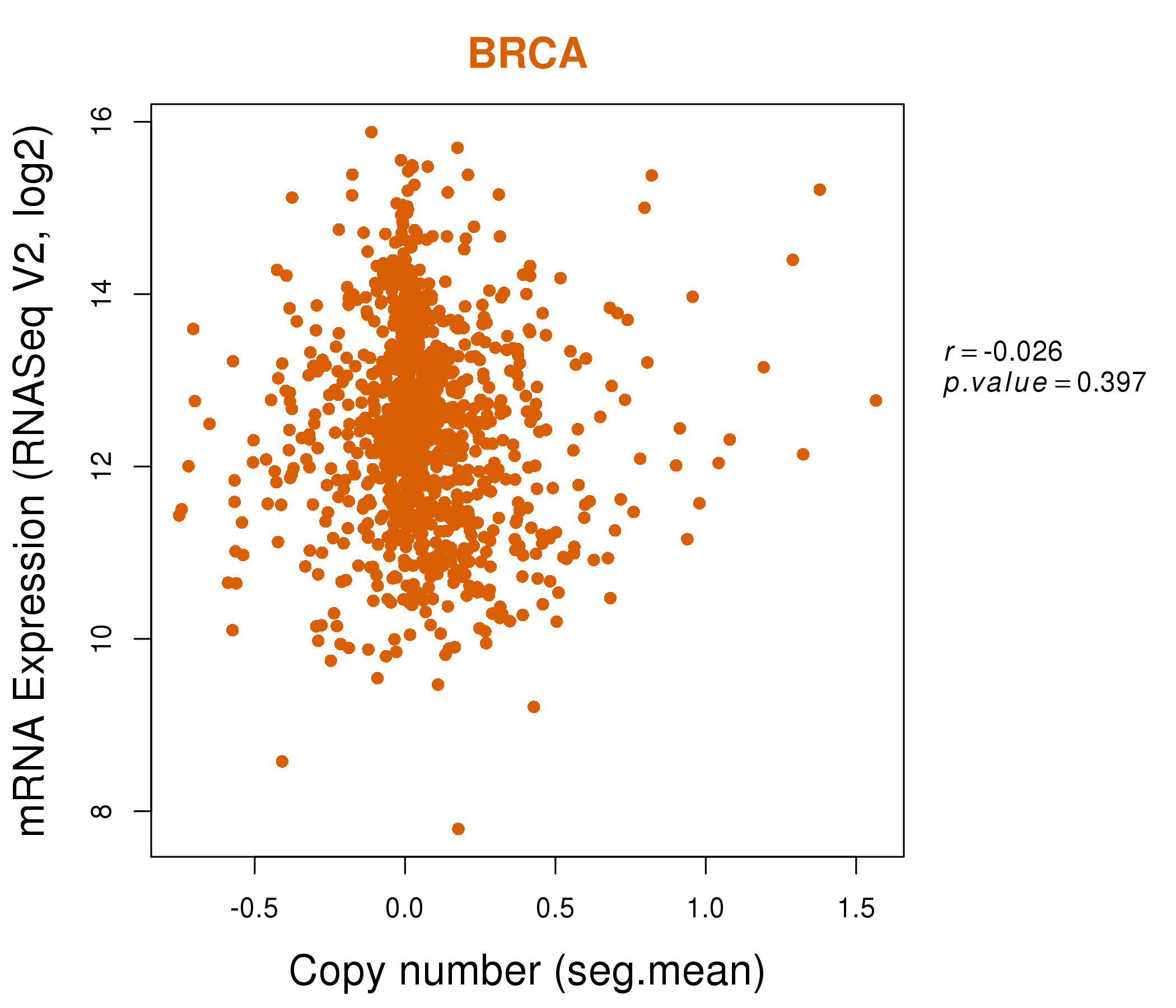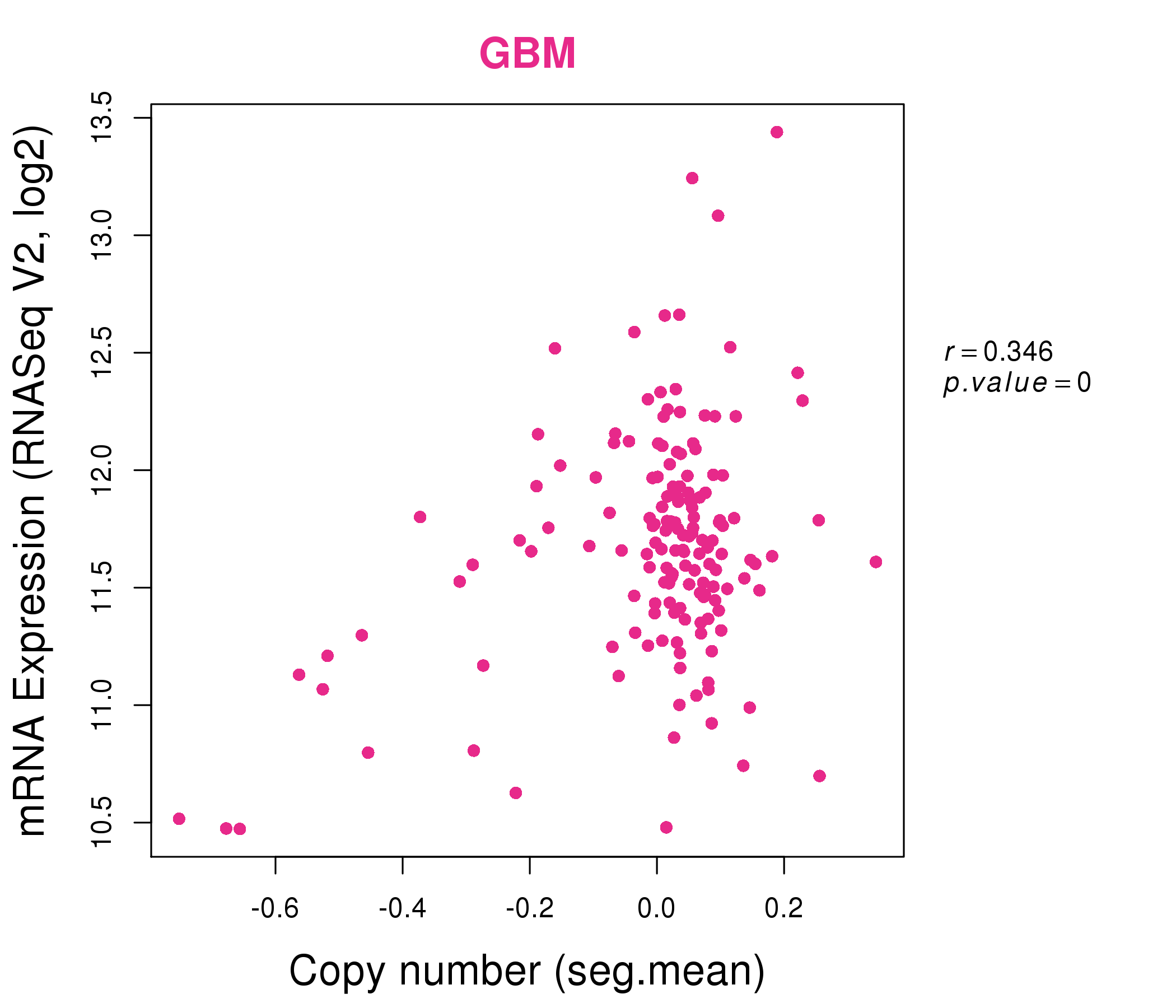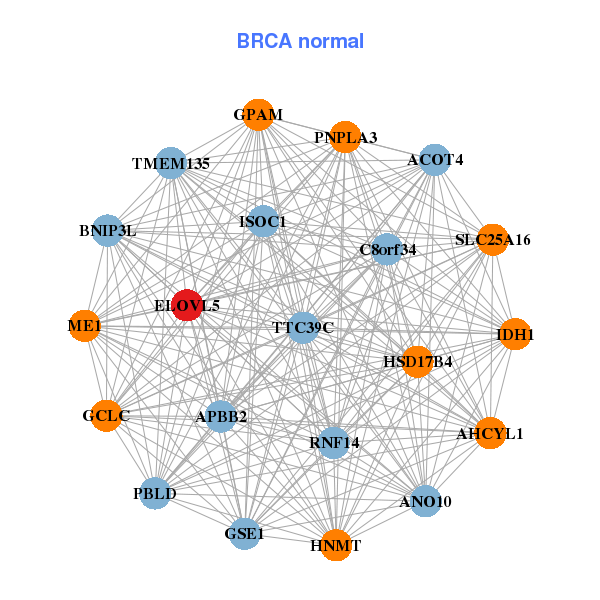|
||||||||||||||||||||||||||||||||||||||||||||||||||||||||||||||||||||||||||||||||||||||||||||||||||||||||||||||||||||||||||||||||||||||||||||||||||||||||||||||||||||||||||||||||||||||||||||||||||||||||||||||||||||||||||||||||||||||||||||||||||||||||||||||||||||||||||||||||||||||||||||||||||||||||||||||||||||||||||
| |
| Phenotypic Information (metabolism pathway, cancer, disease, phenome) |
| |
| |
| Gene-Gene Network Information: Co-Expression Network, Interacting Genes & KEGG |
| |
|
| Gene Summary for ELOVL5 |
| Basic gene info. | Gene symbol | ELOVL5 |
| Gene name | ELOVL fatty acid elongase 5 | |
| Synonyms | HELO1|SCA38|dJ483K16.1 | |
| Cytomap | UCSC genome browser: 6p21.1-p12.1 | |
| Genomic location | chr6 :53132195-53213977 | |
| Type of gene | protein-coding | |
| RefGenes | NM_001242828.1, NM_001242830.1,NM_001242831.1,NM_001301856.1,NM_021814.4, | |
| Ensembl id | ENSG00000012660 | |
| Description | 3-keto acyl-CoA synthase ELOVL5ELOVL FA elongase 5ELOVL family member 5, elongation of long chain fatty acids (FEN1/Elo2, SUR4/Elo3-like, yeast)elongation of very long chain fatty acids protein 5fatty acid elongase 1homolog of yeast long chain polyun | |
| Modification date | 20141212 | |
| dbXrefs | MIM : 611805 | |
| HGNC : HGNC | ||
| Ensembl : ENSG00000012660 | ||
| HPRD : 13268 | ||
| Vega : OTTHUMG00000016249 | ||
| Protein | UniProt: go to UniProt's Cross Reference DB Table | |
| Expression | CleanEX: HS_ELOVL5 | |
| BioGPS: 60481 | ||
| Gene Expression Atlas: ENSG00000012660 | ||
| The Human Protein Atlas: ENSG00000012660 | ||
| Pathway | NCI Pathway Interaction Database: ELOVL5 | |
| KEGG: ELOVL5 | ||
| REACTOME: ELOVL5 | ||
| ConsensusPathDB | ||
| Pathway Commons: ELOVL5 | ||
| Metabolism | MetaCyc: ELOVL5 | |
| HUMANCyc: ELOVL5 | ||
| Regulation | Ensembl's Regulation: ENSG00000012660 | |
| miRBase: chr6 :53,132,195-53,213,977 | ||
| TargetScan: NM_001242828 | ||
| cisRED: ENSG00000012660 | ||
| Context | iHOP: ELOVL5 | |
| cancer metabolism search in PubMed: ELOVL5 | ||
| UCL Cancer Institute: ELOVL5 | ||
| Assigned class in ccmGDB | C | |
| Top |
| Phenotypic Information for ELOVL5(metabolism pathway, cancer, disease, phenome) |
| Cancer | CGAP: ELOVL5 |
| Familial Cancer Database: ELOVL5 | |
| * This gene is included in those cancer gene databases. |
|
|
|
|
|
|
| ||||||||||||||||||||||||||||||||||||||||||||||||||||||||||||||||||||||||||||||||||||||||||||||||||||||||||||||||||||||||||||||||||||||||||||||||||||||||||||||||||||||||||||||||||||||||||||||||||||||||||||||||||||||||||||||||||||||||||||||||||||||||||||||||||||||||||||||||||||||||||||||||||||||||||||||||||||
Oncogene 1 | Significant driver gene in | |||||||||||||||||||||||||||||||||||||||||||||||||||||||||||||||||||||||||||||||||||||||||||||||||||||||||||||||||||||||||||||||||||||||||||||||||||||||||||||||||||||||||||||||||||||||||||||||||||||||||||||||||||||||||||||||||||||||||||||||||||||||||||||||||||||||||||||||||||||||||||||||||||||||||||||||||||||||||
| cf) number; DB name 1 Oncogene; http://nar.oxfordjournals.org/content/35/suppl_1/D721.long, 2 Tumor Suppressor gene; https://bioinfo.uth.edu/TSGene/, 3 Cancer Gene Census; http://www.nature.com/nrc/journal/v4/n3/abs/nrc1299.html, 4 CancerGenes; http://nar.oxfordjournals.org/content/35/suppl_1/D721.long, 5 Network of Cancer Gene; http://ncg.kcl.ac.uk/index.php, 1Therapeutic Vulnerabilities in Cancer; http://cbio.mskcc.org/cancergenomics/statius/ |
| REACTOME_METABOLISM_OF_LIPIDS_AND_LIPOPROTEINS | |
| OMIM | |
| Orphanet | |
| Disease | KEGG Disease: ELOVL5 |
| MedGen: ELOVL5 (Human Medical Genetics with Condition) | |
| ClinVar: ELOVL5 | |
| Phenotype | MGI: ELOVL5 (International Mouse Phenotyping Consortium) |
| PhenomicDB: ELOVL5 | |
| Mutations for ELOVL5 |
| * Under tables are showing count per each tissue to give us broad intuition about tissue specific mutation patterns.You can go to the detailed page for each mutation database's web site. |
| - Statistics for Tissue and Mutation type | Top |
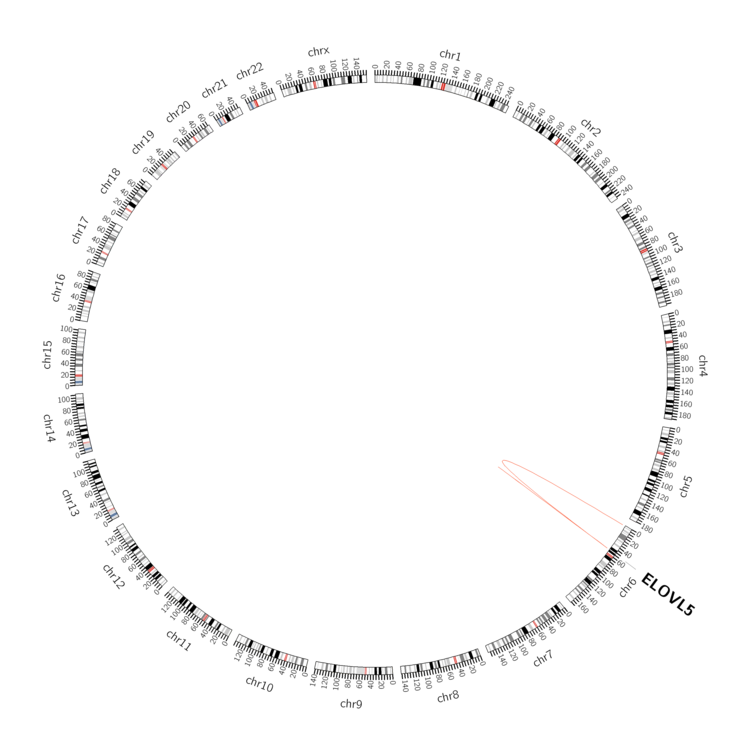 |
| - For Inter-chromosomal Variations |
| There's no inter-chromosomal structural variation. |
| - For Intra-chromosomal Variations |
| * Intra-chromosomal variantions includes 'intrachromosomal amplicon to amplicon', 'intrachromosomal amplicon to non-amplified dna', 'intrachromosomal deletion', 'intrachromosomal fold-back inversion', 'intrachromosomal inversion', 'intrachromosomal tandem duplication', 'Intrachromosomal unknown type', 'intrachromosomal with inverted orientation', 'intrachromosomal with non-inverted orientation'. |
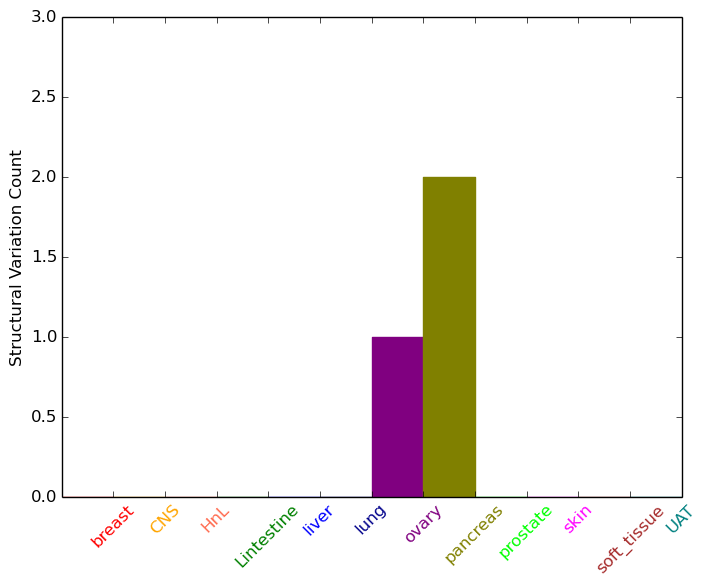 |
| Sample | Symbol_a | Chr_a | Start_a | End_a | Symbol_b | Chr_b | Start_b | End_b |
| ovary | ELOVL5 | chr6 | 53145522 | 53145542 | ELOVL5 | chr6 | 53158858 | 53158878 |
| pancreas | ELOVL5 | chr6 | 53150613 | 53150633 | chr6 | 1213284 | 1213304 | |
| pancreas | ELOVL5 | chr6 | 53169370 | 53169390 | chr6 | 53065657 | 53065677 |
| cf) Tissue number; Tissue name (1;Breast, 2;Central_nervous_system, 3;Haematopoietic_and_lymphoid_tissue, 4;Large_intestine, 5;Liver, 6;Lung, 7;Ovary, 8;Pancreas, 9;Prostate, 10;Skin, 11;Soft_tissue, 12;Upper_aerodigestive_tract) |
| * From mRNA Sanger sequences, Chitars2.0 arranged chimeric transcripts. This table shows ELOVL5 related fusion information. |
| ID | Head Gene | Tail Gene | Accession | Gene_a | qStart_a | qEnd_a | Chromosome_a | tStart_a | tEnd_a | Gene_a | qStart_a | qEnd_a | Chromosome_a | tStart_a | tEnd_a |
| DB155046 | MTERF | 1 | 332 | 7 | 91503483 | 91503814 | ELOVL5 | 332 | 589 | 6 | 53156675 | 53213719 | |
| AV686607 | USF1 | 1 | 91 | 1 | 161013096 | 161014737 | ELOVL5 | 84 | 331 | 6 | 53132572 | 53132882 | |
| BM827569 | CYBA | 26 | 304 | 16 | 88712556 | 88714522 | ELOVL5 | 299 | 589 | 6 | 53156583 | 53213660 | |
| BE929601 | ELOVL5 | 4 | 138 | 6 | 53133036 | 53133172 | SGIP1 | 139 | 158 | 1 | 67175153 | 67175172 | |
| BF096087 | DDX5 | 20 | 249 | 17 | 62499050 | 62499369 | ELOVL5 | 248 | 549 | 6 | 53138076 | 53141039 | |
| BE929559 | ELOVL5 | 20 | 156 | 6 | 53133033 | 53133172 | SGIP1 | 157 | 176 | 1 | 67175153 | 67175172 | |
| Top |
| Mutation type/ Tissue ID | brca | cns | cerv | endome | haematopo | kidn | Lintest | liver | lung | ns | ovary | pancre | prost | skin | stoma | thyro | urina | |||
| Total # sample | 4 | 1 | 2 | 2 | ||||||||||||||||
| GAIN (# sample) | 4 | 2 | ||||||||||||||||||
| LOSS (# sample) | 1 | 2 |
| cf) Tissue ID; Tissue type (1; Breast, 2; Central_nervous_system, 3; Cervix, 4; Endometrium, 5; Haematopoietic_and_lymphoid_tissue, 6; Kidney, 7; Large_intestine, 8; Liver, 9; Lung, 10; NS, 11; Ovary, 12; Pancreas, 13; Prostate, 14; Skin, 15; Stomach, 16; Thyroid, 17; Urinary_tract) |
| Top |
|
 |
| Top |
| Stat. for Non-Synonymous SNVs (# total SNVs=20) | (# total SNVs=8) |
 |  |
(# total SNVs=1) | (# total SNVs=0) |
 |
| Top |
| * When you move the cursor on each content, you can see more deailed mutation information on the Tooltip. Those are primary_site,primary_histology,mutation(aa),pubmedID. |
| GRCh37 position | Mutation(aa) | Unique sampleID count |
| chr6:53141056-53141056 | p.? | 2 |
| chr6:53134010-53134010 | p.G272A | 2 |
| chr6:53135507-53135507 | p.I214V | 2 |
| chr6:53160476-53160476 | p.L8I | 2 |
| chr6:53139937-53139937 | p.S149S | 2 |
| chr6:53133959-53133959 | p.N289S | 1 |
| chr6:53139965-53139965 | p.T140M | 1 |
| chr6:53156595-53156595 | p.L75L | 1 |
| chr6:53133964-53133964 | p.L287L | 1 |
| chr6:53139983-53139983 | p.K134T | 1 |
| Top |
|
 |
| Point Mutation/ Tissue ID | 1 | 2 | 3 | 4 | 5 | 6 | 7 | 8 | 9 | 10 | 11 | 12 | 13 | 14 | 15 | 16 | 17 | 18 | 19 | 20 |
| # sample | 2 | 3 | 3 | 2 | 1 | 1 | 1 | 1 | 2 | 1 | 3 | |||||||||
| # mutation | 2 | 3 | 3 | 2 | 1 | 1 | 2 | 1 | 2 | 1 | 3 | |||||||||
| nonsynonymous SNV | 1 | 2 | 3 | 1 | 1 | 2 | 1 | 2 | 2 | |||||||||||
| synonymous SNV | 1 | 1 | 1 | 1 | 1 | 1 |
| cf) Tissue ID; Tissue type (1; BLCA[Bladder Urothelial Carcinoma], 2; BRCA[Breast invasive carcinoma], 3; CESC[Cervical squamous cell carcinoma and endocervical adenocarcinoma], 4; COAD[Colon adenocarcinoma], 5; GBM[Glioblastoma multiforme], 6; Glioma Low Grade, 7; HNSC[Head and Neck squamous cell carcinoma], 8; KICH[Kidney Chromophobe], 9; KIRC[Kidney renal clear cell carcinoma], 10; KIRP[Kidney renal papillary cell carcinoma], 11; LAML[Acute Myeloid Leukemia], 12; LUAD[Lung adenocarcinoma], 13; LUSC[Lung squamous cell carcinoma], 14; OV[Ovarian serous cystadenocarcinoma ], 15; PAAD[Pancreatic adenocarcinoma], 16; PRAD[Prostate adenocarcinoma], 17; SKCM[Skin Cutaneous Melanoma], 18:STAD[Stomach adenocarcinoma], 19:THCA[Thyroid carcinoma], 20:UCEC[Uterine Corpus Endometrial Carcinoma]) |
| Top |
| * We represented just top 10 SNVs. When you move the cursor on each content, you can see more deailed mutation information on the Tooltip. Those are primary_site, primary_histology, mutation(aa), pubmedID. |
| Genomic Position | Mutation(aa) | Unique sampleID count |
| chr6:53134010 | p.W230C,ELOVL5 | 2 |
| chr6:53135398 | p.T140M,ELOVL5 | 1 |
| chr6:53141026 | p.K134T,ELOVL5 | 1 |
| chr6:53135507 | p.G103E,ELOVL5 | 1 |
| chr6:53156612 | p.R100H,ELOVL5 | 1 |
| chr6:53138060 | p.Y92C,ELOVL5 | 1 |
| chr6:53156718 | p.L70F,ELOVL5 | 1 |
| chr6:53138102 | p.P34P,ELOVL5 | 1 |
| chr6:53156755 | p.L258L,ELOVL5 | 1 |
| chr6:53139895 | p.R22T,ELOVL5 | 1 |
| * Copy number data were extracted from TCGA using R package TCGA-Assembler. The URLs of all public data files on TCGA DCC data server were gathered on Jan-05-2015. Function ProcessCNAData in TCGA-Assembler package was used to obtain gene-level copy number value which is calculated as the average copy number of the genomic region of a gene. |
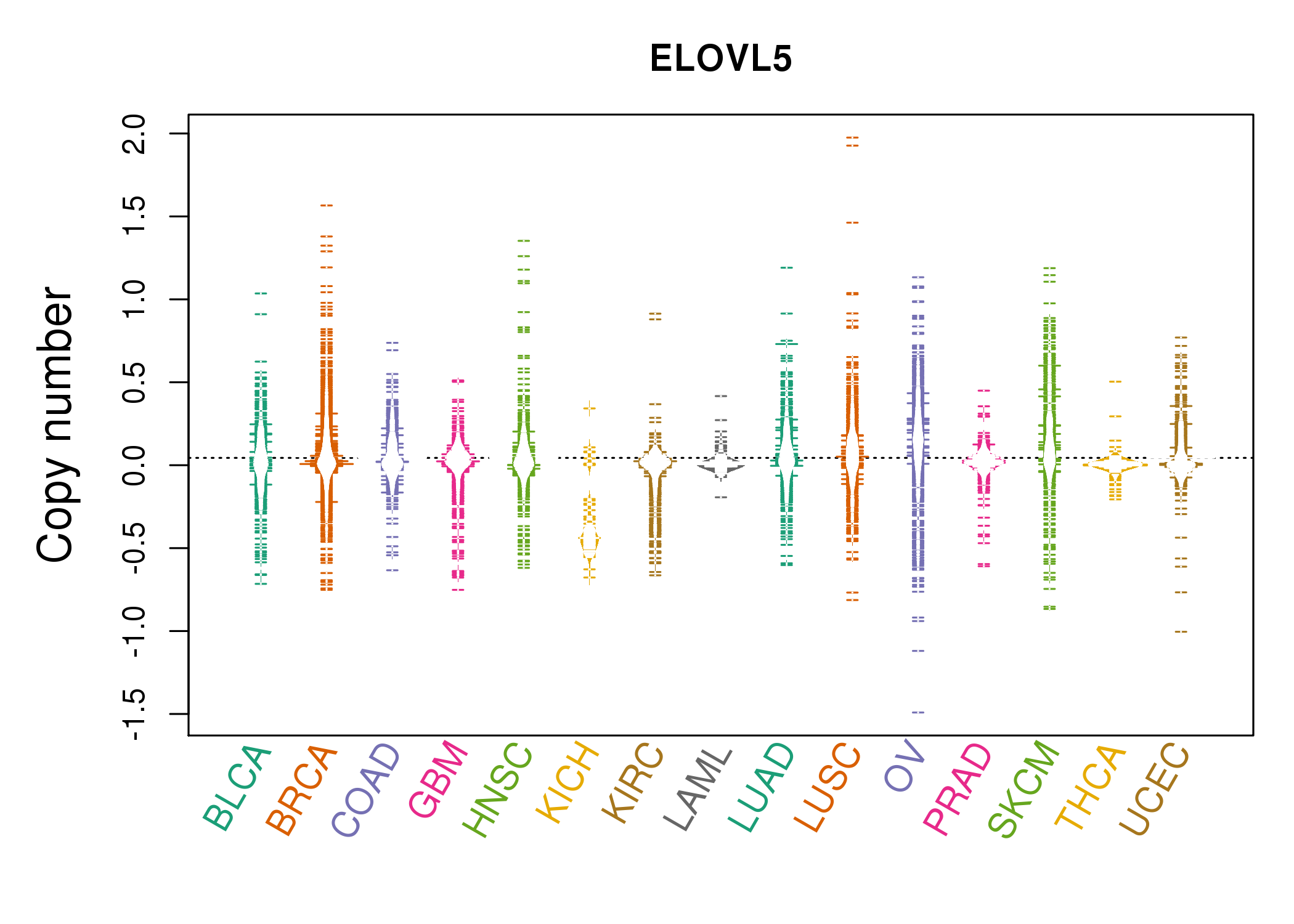 |
| cf) Tissue ID[Tissue type]: BLCA[Bladder Urothelial Carcinoma], BRCA[Breast invasive carcinoma], CESC[Cervical squamous cell carcinoma and endocervical adenocarcinoma], COAD[Colon adenocarcinoma], GBM[Glioblastoma multiforme], Glioma Low Grade, HNSC[Head and Neck squamous cell carcinoma], KICH[Kidney Chromophobe], KIRC[Kidney renal clear cell carcinoma], KIRP[Kidney renal papillary cell carcinoma], LAML[Acute Myeloid Leukemia], LUAD[Lung adenocarcinoma], LUSC[Lung squamous cell carcinoma], OV[Ovarian serous cystadenocarcinoma ], PAAD[Pancreatic adenocarcinoma], PRAD[Prostate adenocarcinoma], SKCM[Skin Cutaneous Melanoma], STAD[Stomach adenocarcinoma], THCA[Thyroid carcinoma], UCEC[Uterine Corpus Endometrial Carcinoma] |
| Top |
| Gene Expression for ELOVL5 |
| * CCLE gene expression data were extracted from CCLE_Expression_Entrez_2012-10-18.res: Gene-centric RMA-normalized mRNA expression data. |
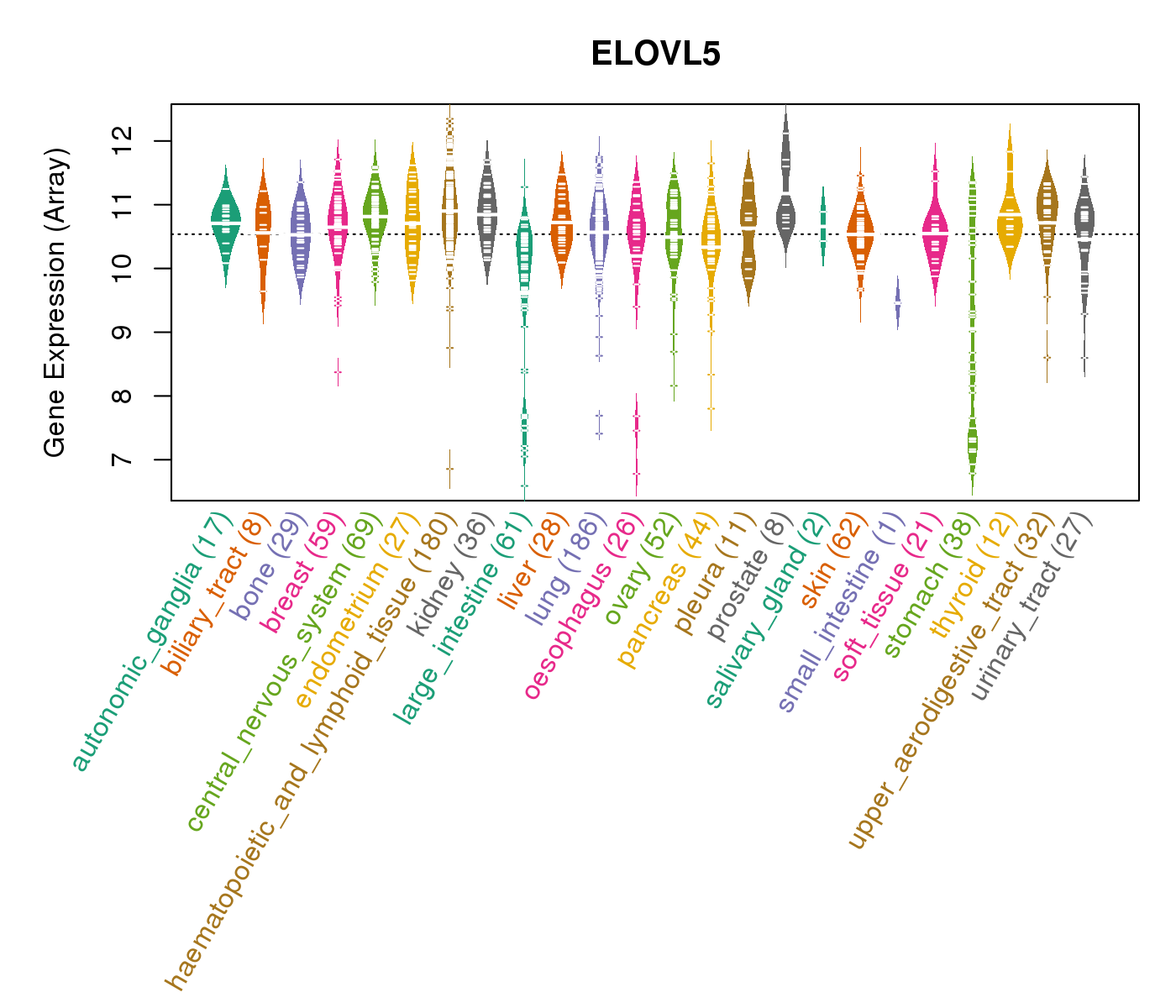 |
| * Normalized gene expression data of RNASeqV2 was extracted from TCGA using R package TCGA-Assembler. The URLs of all public data files on TCGA DCC data server were gathered at Jan-05-2015. Only eight cancer types have enough normal control samples for differential expression analysis. (t test, adjusted p<0.05 (using Benjamini-Hochberg FDR)) |
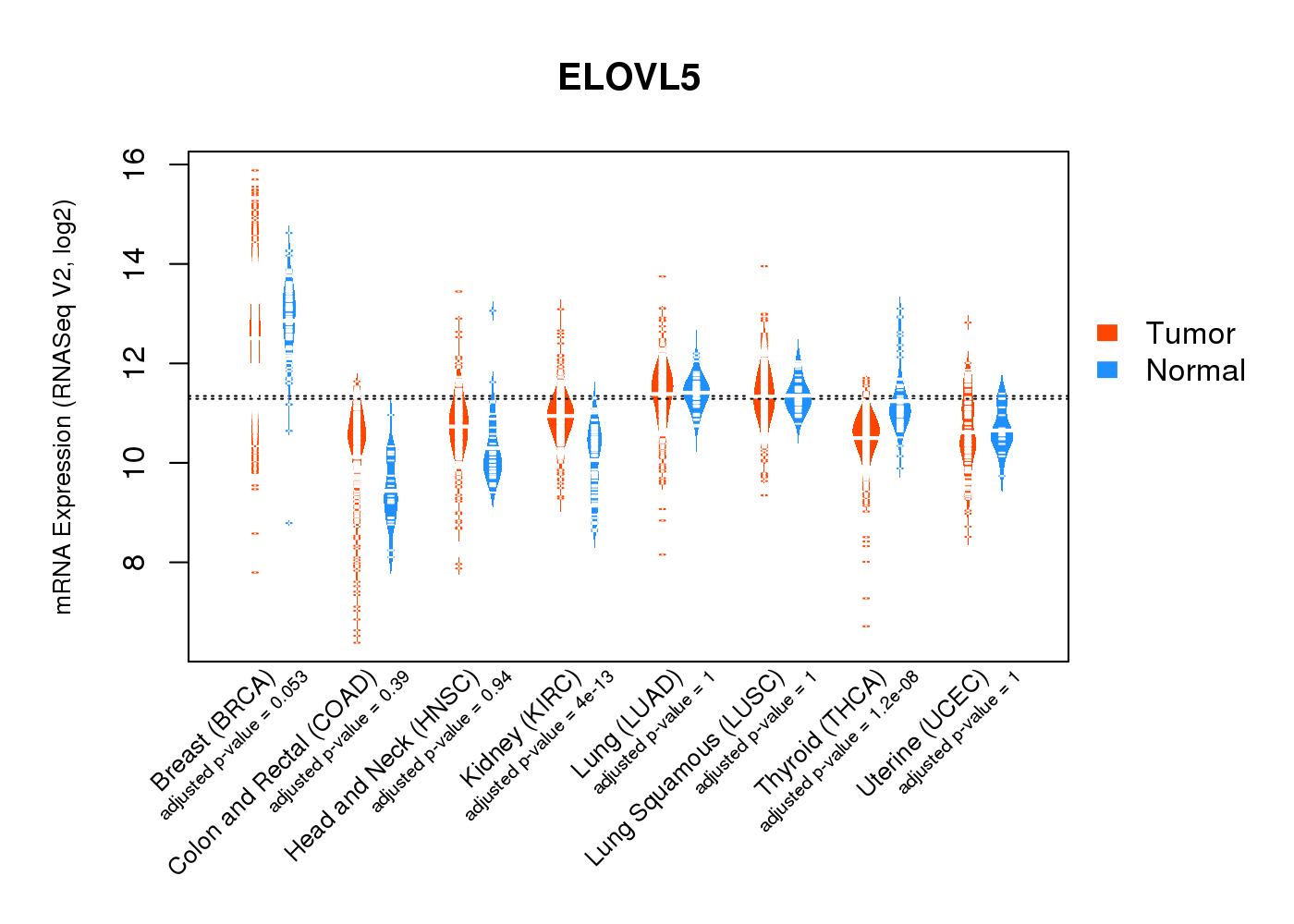 |
| Top |
| * This plots show the correlation between CNV and gene expression. |
: Open all plots for all cancer types
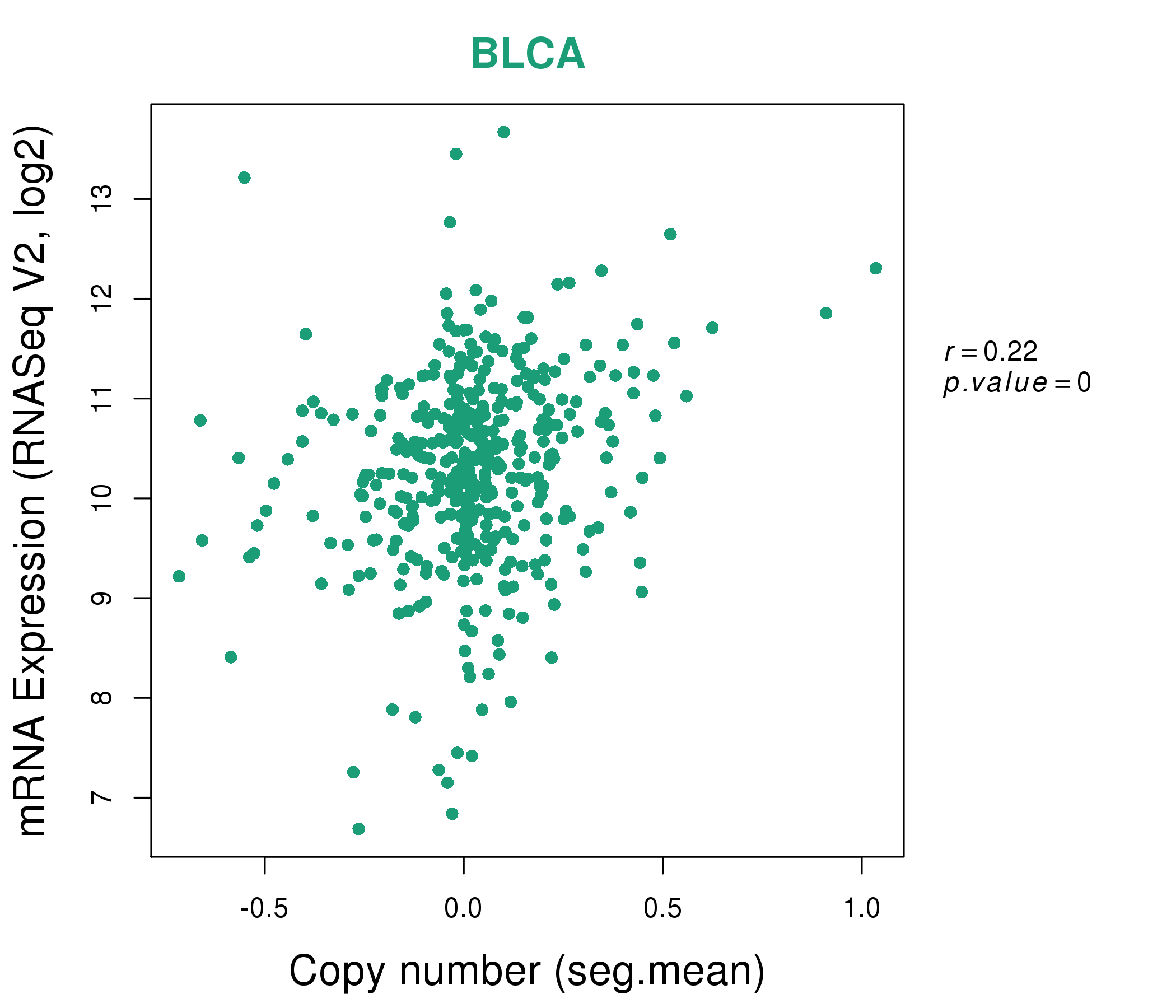 |
|
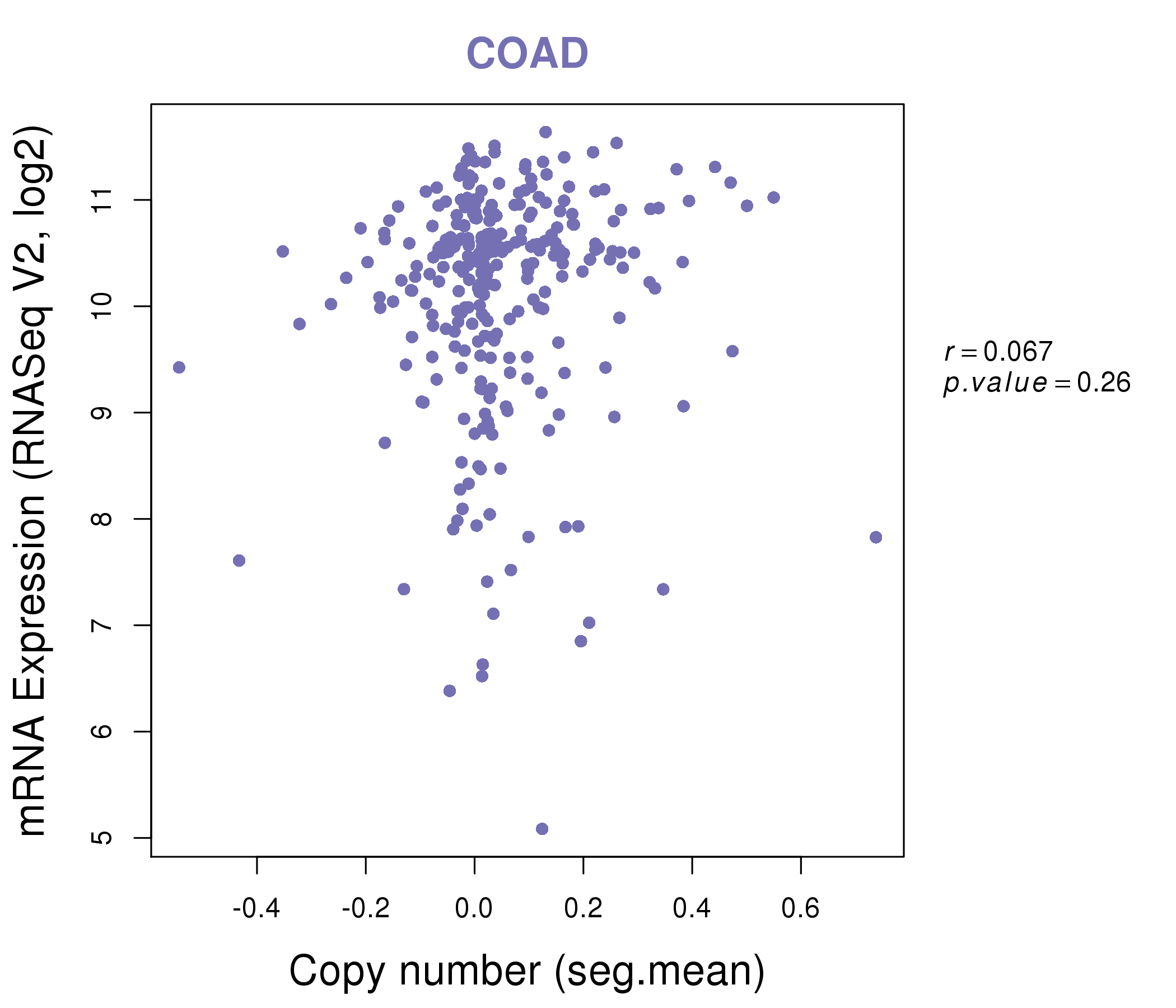 |
|
| Top |
| Gene-Gene Network Information |
| * Co-Expression network figures were drawn using R package igraph. Only the top 20 genes with the highest correlations were shown. Red circle: input gene, orange circle: cell metabolism gene, sky circle: other gene |
: Open all plots for all cancer types
 |
|
| AHCYL1,ANKHD1-EIF4EBP3,C1orf21,KIAA0825,DNAJC16,ELOVL5,FAM114A2, FOXA1,GLUL,HNRNPH2,FAM214A,LOC728606,LRIG1,MCCC2, NUDT12,PIGV,SIAE,SPATA6,SPG11,TMEM26,XBP1 | ACOT4,AHCYL1,ANO10,APBB2,BNIP3L,C8orf34,ELOVL5, GCLC,GPAM,HNMT,HSD17B4,IDH1,ISOC1,GSE1, ME1,PBLD,PNPLA3,RNF14,SLC25A16,TMEM135,TTC39C |
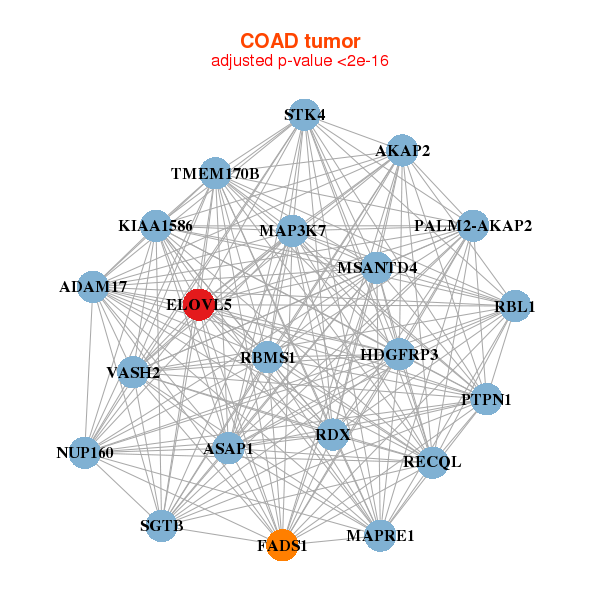 |
|
| ADAM17,AKAP2,ASAP1,ELOVL5,FADS1,HDGFRP3,KIAA1586, MSANTD4,MAP3K7,MAPRE1,NUP160,PALM2-AKAP2,PTPN1,RBL1, RBMS1,RDX,RECQL,SGTB,STK4,TMEM170B,VASH2 | C1orf216,CADM4,CLIP4,DEGS1,DENND5A,EFEMP2,ELOVL5, FIBIN,GNAI2,GUCY1A3,KLHL5,MRAS,NCALD,SLC9B2, PRNP,QKI,RAB31,RHOQ,SPG20,SULF1,ZCCHC24 |
| * Co-Expression network figures were drawn using R package igraph. Only the top 20 genes with the highest correlations were shown. Red circle: input gene, orange circle: cell metabolism gene, sky circle: other gene |
: Open all plots for all cancer types
| Top |
: Open all interacting genes' information including KEGG pathway for all interacting genes from DAVID
| Top |
| Pharmacological Information for ELOVL5 |
| There's no related Drug. |
| Top |
| Cross referenced IDs for ELOVL5 |
| * We obtained these cross-references from Uniprot database. It covers 150 different DBs, 18 categories. http://www.uniprot.org/help/cross_references_section |
: Open all cross reference information
|
Copyright © 2016-Present - The Univsersity of Texas Health Science Center at Houston @ |






